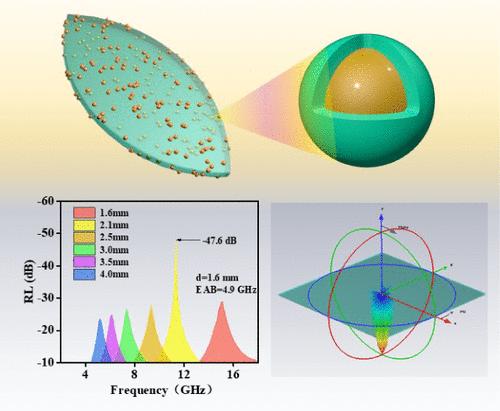高效微波吸收叶状Co/C纳米片的合成
IF 3.9
2区 化学
Q2 CHEMISTRY, MULTIDISCIPLINARY
引用次数: 0
摘要
电磁吸收材料微结构的精细工程设计为实现优异的电磁波吸收性能提供了无限的潜力。本研究以Co/Zn-ZIF-L为前驱体,采用快速热解法制备了叶状Co/C纳米片。在这里,Co纳米颗粒(NPs)被均匀地限制在叶状多孔碳基体中,形成吸引的异质结构。合适的二维形貌和Co/C二元组分使复合材料具有优异的阻抗匹配和协同EM损耗,具有优异的微波吸收和雷达隐身性能。当填料含量低至25 wt %时,2.1 mm厚度处的强吸收强度为- 47.6 dB, 1.6 mm厚度处的宽有效带宽为4.9 GHz。在探测θ为0°时,雷达截面(RCS)减小值最大达到17.9 dB·m2。因此,预计叶状Co/C纳米片在电磁波吸收和雷达隐身领域具有显著的优势,为未来探索高性能电磁波吸收材料铺平了道路。本文章由计算机程序翻译,如有差异,请以英文原文为准。

Synthesis of a Leaf-Like Co/C Nanosheet for Efficient Microwave Absorption
Elaborate engineering of the microstructure of electromagnetic (EM) absorption materials affords infinite potential for achieving superior EM wave absorption performance. In this work, a leaf-like Co/C nanosheet was rationally fabricated by a facile pyrolysis of a CoZn-based zeolitic imidazolate framework-L (Co/Zn-ZIF-L) precursor. Herein, Co nanoparticles (NPs) are uniformly confined in the leaf-like porous carbon matrix, forming attractive heterostructures. A suitable 2D morphology and Co/C binary components endow the composite with superior impedance matching and synergetic EM losses for excellent microwave absorption and radar stealth performance. When the filler content is as low as 25 wt %, the strong absorption intensity of −47.6 dB is reached at a thickness of 2.1 mm, and a broad effective bandwidth of 4.9 GHz is achieved at a thickness of only 1.6 mm. At the detection theta of 0°, the maximum radar cross-sectional (RCS) reduction value reaches 17.9 dB·m2. Hence, it is expected that the leaf-like Co/C nanosheet exhibits significant advantages in the field of EM wave absorption and radar stealth, which paves the way for future exploration of high-performance EM wave absorption materials.
求助全文
通过发布文献求助,成功后即可免费获取论文全文。
去求助
来源期刊

Langmuir
化学-材料科学:综合
CiteScore
6.50
自引率
10.30%
发文量
1464
审稿时长
2.1 months
期刊介绍:
Langmuir is an interdisciplinary journal publishing articles in the following subject categories:
Colloids: surfactants and self-assembly, dispersions, emulsions, foams
Interfaces: adsorption, reactions, films, forces
Biological Interfaces: biocolloids, biomolecular and biomimetic materials
Materials: nano- and mesostructured materials, polymers, gels, liquid crystals
Electrochemistry: interfacial charge transfer, charge transport, electrocatalysis, electrokinetic phenomena, bioelectrochemistry
Devices and Applications: sensors, fluidics, patterning, catalysis, photonic crystals
However, when high-impact, original work is submitted that does not fit within the above categories, decisions to accept or decline such papers will be based on one criteria: What Would Irving Do?
Langmuir ranks #2 in citations out of 136 journals in the category of Physical Chemistry with 113,157 total citations. The journal received an Impact Factor of 4.384*.
This journal is also indexed in the categories of Materials Science (ranked #1) and Multidisciplinary Chemistry (ranked #5).
 求助内容:
求助内容: 应助结果提醒方式:
应助结果提醒方式:


